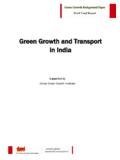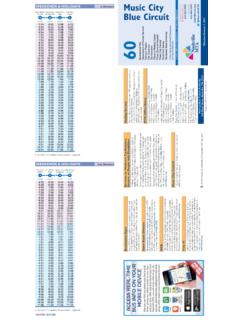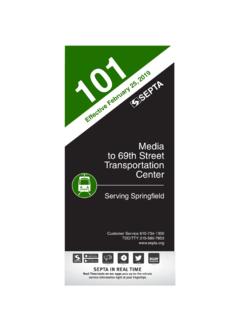Transcription of New York City Department of Transportation Bus Ridership ...
1 New york city Department of Transportation Bus Ridership Survey and route Analysis 28 Chapter 4 Operating and Financial Performance This chapter provides an inventory of National Transit Database information and performance measures collected by each company. These include Ridership (unlinked passenger trips), hours and miles of service provided, and cost and revenue figures. It is important to note that the data presented here was obtained by NYCDOT and National Transit Database reports, which was prepared by the individual companies. Data collected as part of the bus Ridership survey is not presented in this chapter.
2 System Ridership , Vehicle Miles, and Vehicle Hours Trends (1997-2001) Data for this section was obtained from a number of sources, covering the years 1997 through 2001. Ridership figures for the years 1997 through 2001 are presented for the private companies on Table 4-1. This data was compiled from reports provided by the companies to NYCDOT. reports are based on data collected from the fareboxes on each individual bus. A number of other data sources were considered including National Transit Database, as well as form 17A financial forms. Each individual Ridership source reported Ridership figures based on different data, resulting in different Ridership figures from each source.
3 Since come directly from the farebox, it was decided that these figures were the most appropriate figures to use. From 1997 to 2001, Ridership grew by 22%. While all the companies have had significant gains in Ridership , Triboro Coach has had the highest percent of Ridership growth, with an increase of 34%. Queens Surface had the smallest Ridership increase from 1997 however it still grew quite significantly, 17%. There are a few likely reasons that Ridership has increased substantially in the last few years. One reason that Ridership has grown is because of discounts offered by Metrocard. These discounts have created free transfers for passengers who use the bus to access the subway.
4 Also, the unlimited ride Metrocards has created an incentive for using bus service for discretionary trips. Also, increases in service, shown on Tables 4-2 and 4-3, have resulted in more people willing to use the private buses. The reduced fare on express buses, from $ to $ in 1997, has also increased the attractiveness of these services, resulting in more Ridership . Table 4-1: Ridership Trends Company 1997 1998 1999 2000 2001 Percent Change Green Bus Lines 29,262,754 31,596,64333,723,379 35,050,405 35,773,019 18% Jamaica Buses 8,555,007 8,229,040 10,236,127 11,059,522 11,081,463 23% Liberty Lines 2,406,391 2,807,296 3,029,845 2,974,187 2,935,898 18% New york Bus Service 2,949,000 3,255,553 3,191,314 3,943,879 4,014,399 27% Queens Surface 24,025,523 24,619,88226,509,757 28,079,215 29,029,359 17% Triboro Coach 17,666,028 21,030,43223,778,878 26,511,966 26,634,949 34% Total 84,864,703 91,538,846100,469,300 107,619,174 109,469,08722% Source.
5 Form Reports and NYCDOT New york city Department of Transportation Bus Ridership Survey and route Analysis 29 Vehicle miles grew by almost 12% between 1997 and 2001. The companies that have had the largest increase in vehicle miles, in both percent and actual miles, are companies that have a higher portion of express bus service. New york Bus Service had the highest percent increase in vehicle miles with a 24% increase, while Queens Surface saw the highest increase in actual miles, increasing by 904,392 miles since 1997. Liberty Lines actually experienced a slight decline in mileage since 1997, 41,016 miles or about 1% which is due to a new facility for express services located that reduced the deadhead miles operated by Liberty Lines.
6 Vehicle Miles for each company from 1997 to 2001 is shown on Table 4-2. The additional vehicle miles show that service has been added on many routes since 1997. Very little service has been added during peak periods due to equipment limitations. Much of the service has been increased during off-peak periods where buses would ordinarily sit idle at the depot. Midday service has seen a lot of growth, while growth in evening and nighttime periods has also occurred. Weekends are another time period where service has increased in recent years. Growth of express services are also a reason why vehicle miles have climbed, since these services tend to have a lot of deadhead mileage associated with them as they tend to operate only in one direction during peak periods.
7 Table 4-2: Vehicle Mile Trends Company 1997 1998 1999 2000 2001 Percent Change Green Bus Lines 5,827,675 6,260,059 6,664,710 6,733,294 6,559,348 13% Jamaica Buses 2,181,703 2,223,517 2,232,158 2,226,155 2,227,443 2% Liberty Lines 2,842,597 2,879,288 2,892,058 2,814,951 2,801,581 -1% New york Bus Service 2,855,165 3,087,932 3,305,481 3,524,746 3,552,347 24% Queens Surface 7,474,846 7,693,954 8,202,096 8,352,239 8,379,238 12% Triboro Coach 4,193,050 4.
8 183,877 4,608,787 4,715,577 4,841,272 15% Total 25,375,036 26,328,627 27,905,290 28,366,962 28,361,22912% Source: NTD and NYCDOT Table 4-3 shows vehicle hour trends from 1997 to 2001. Since 1997, vehicle hours have grown by about 19% or by 470,680 hours despite the large gains in Ridership experienced by each company. Jamaica Buses has seen the least growth in vehicle hours, only increasing by 6,621 or 3% during this time period. New york Bus Service has grown by 23%, which is the highest percentage growth, while Triboro Coach has seen the most actual hour growth with 169,278 hours. Vehicle hours have grown for a number of reasons.
9 One reason is due to the increase in off-peak services provided that is shown on Table 4-3. Another reason is the increase in Ridership , as shown on Table 4-1, has resulted in more crowding aboard buses, increasing the number of requested stops, and dwell time at those stops. Decreasing vehicle speeds New york city Department of Transportation Bus Ridership Survey and route Analysis 30largely due to traffic congestion has also contributed to the large in increase in vehicle hours. Growth in express services is another reason that vehicles hours have grown. This is because these services tend to operate in peak directions primarily during peak periods, thus operate a lot of deadhead hours, as well as travel time that is affected by peak period traffic conditions in Manhattan and area expressways.
10 Table 4-3: Vehicle Hour Trends Company 1997 1998 1999 2000 2001 Percent Change Green Bus Lines 609,770 681,605 710,852 707,825 713,687 17% Jamaica Buses 237,844 244,066 247,026 243,490 244,465 3% Liberty Lines 230,509 228,591 230,259 228,241 266,479 16% New york Bus Service 242,750 261,167 279,781 297,245 298,504 23% Queens Surface 665,800 693,062 729,943 754,821 764,940 15% Triboro Coach 427.

















